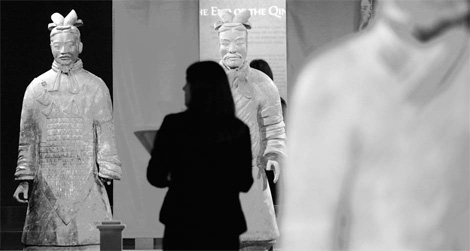

 |
|
A woman looks at Terracotta Warriors on display at the National Geographic Museum in Washington.[Agencies] |
WASHINGTON: National Geographic Museum director Susan Norton gazed at a piece of armor constructed of hundreds of limestone pieces the size of mahjong tiles and strung together with copper wire.
"(These were created) 2,200 years ago, (examine) the level of sophistication of this artwork," Norton said.
She was referring to the discoveries of an ancient Chinese treasure - the Terracotta Warriors of Emperor Qin Shihuang, buried deep in the mountains of Shaanxi province.
A selection of these terracotta figures recently arrived in Washington as part of a four-city tour of the United States. The exhibit has been one of the most significant ones hosted by the National Geographic Society.
"There are many great treasures in China that don't travel," Norton said. "The Forbidden City doesn't travel. The Great Wall doesn't travel. We're lucky that Shaanxi allows a certain number of (terracotta figures) to travel at any given time."
The exhibit, Terra Cotta Warriors: Guardians of China's First Emperor, features the largest number of terracotta figures to travel to the US from Shaanxi province for a single exhibition. Fifteen terracotta figures and 100 sets of objects are on display at the National Geographic Museum.
Washington is the final stop for the terracotta figures, after exhibitions in Santa Ana, California, Atlanta and Houston. The exhibit was a collaborative effort, among four institutions in each city.
The display in Washington opened on Nov 19 and will remain through March 31. The program includes films, lectures and other events. In addition, the museum is organizing a Chinese New Year celebration with the Chinese Embassy. Performances, films and food will be offered during the Spring Festival.
Large photographs of the Xi'an site line the walls as people file in. The recorded humming of monks lends a somber mood to displays of the large, silent and motionless army of warriors chiseled to protect the long-dead emperor.
Behind glass lie various relics, including jade pieces, coins with an explanation of Emperor Qin's development of a currency system, weapons, dishes, metal wares and other artifacts.
Visitors examine the fine details of those locked-in-time soldiers: Strands of hair pulled into knots, laces on their ankles and even tread on the bottom of their shoes. The final room reveals a large, open space with two replicas of a carriage pulled by four horses on either side of the room, and several figures in different positions. Some retain the original colored paint.
The 15 figures include two infantrymen, a chariot driver, two officers, an armored warrior, two archers and a cavalryman, two musicians, a strongman, a court official, a stable attendant and a horse.
The exhibit space is also the largest devoted to a single exhibit by the National Geographic Museum. It spans 3,658 sq m and involved nearly 25 National Geographic divisions. The map division, for example, created several maps for the exhibit that impressed even officials from Xi'an, who requested copies. The gaming division created an interactive game at the end of the exhibit; the digital lab division produced prints and graphics; the book division licensed a souvenir book; and the television division licensed a film called The Real Emperor Dragon that was shown around the country.
Photographs by Shanghai-based Wang Dagang and National Geographic's O. Louis Mazzatenta, of the excavation sites in Xi'an, illustrate the vast size of the army.
The exhibit also covers China's progress since the figures were discovered in 1974, the background of Emperor Qin and his accomplishments, his plans for the afterlife, and the work of excavators and conservators in preserving the artifacts.
Visitor Lisa Fontaine called the exhibit "beautiful."
"It's hard to fathom that's all been underground waiting for us to find it. It makes me want to see the actual one (site), especially after seeing the photographs and the massive scale of it," she said.
Other visitors agreed.
"It was fascinating," said Dereva Gregory, who was visiting from out of town. "The work that went into the statues is unparalleled at that time. They're gorgeous."